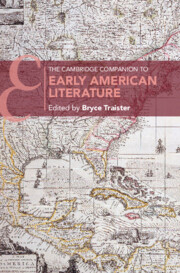Book contents
- The Cambridge Companion to Early American Literature
- The Cambridge Companion to Early American Literature
- Copyright page
- Contents
- Figures
- Contributors
- Introduction
- Part I How to Read (in) Early America
- 1 How to Read Things That Weren’t Written Down in Early America
- 2 How to Read the Natural World
- 3 How to Read Early American Poetry
- 4 How to Read Gender in Early America
- 5 How to Read an Early American Novel
- 6 How to Read Democracy in the Early United States
- Part II Readings in Early America
- Part III Early American Places
- Select Bibliography
- Index
- Cambridge Companions To …
2 - How to Read the Natural World
from Part I - How to Read (in) Early America
Published online by Cambridge University Press: 18 November 2021
- The Cambridge Companion to Early American Literature
- The Cambridge Companion to Early American Literature
- Copyright page
- Contents
- Figures
- Contributors
- Introduction
- Part I How to Read (in) Early America
- 1 How to Read Things That Weren’t Written Down in Early America
- 2 How to Read the Natural World
- 3 How to Read Early American Poetry
- 4 How to Read Gender in Early America
- 5 How to Read an Early American Novel
- 6 How to Read Democracy in the Early United States
- Part II Readings in Early America
- Part III Early American Places
- Select Bibliography
- Index
- Cambridge Companions To …
Summary
Applying a science studies approach to early American literature means focusing on how early modern settler colonialism in the Americas, with all its violence and exploitation, was a knowledge-producing machine. Enslavers and colonizers stole the skills, labor, and resources from enslaved Africans and Indigenous peoples, and in the process forged many of the empirical practices, forms of measurement and categorization, and stratification between types of expertise that we typically recognize as constituting scientific work. Research in early American literature investigates the complexity of particular representations of natural phenomena and traces their circulation within or against powerful narratives that organized culture. This shows how contemporary scientific understandings of natural phenomena are historically and culturally determined and calls attention to the settler colonial work scientific expertise can continue to do in the present and contributing to the project of imagining alternative uses for it. This chapter argues for an approach to reading nature in early American literature that is modeled on acts of translation rather than processes of decoding. This difference is as subtle as it is essential for opening up the present to simultaneous scrutiny as critics confront an archive produced by the violent structures of the past.
Keywords
- Type
- Chapter
- Information
- The Cambridge Companion to Early American Literature , pp. 32 - 48Publisher: Cambridge University PressPrint publication year: 2021

